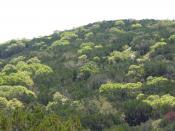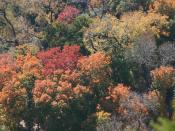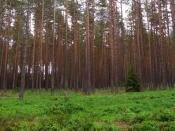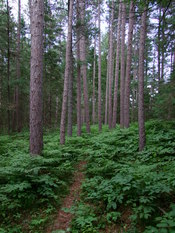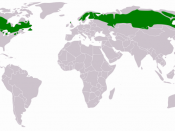Notes for Chapter 5 Lesson 2 Part 2 1. The taiga is a cold region of cone-bearing evergreen trees.
2. The Northern Coniferous Forest is also called a biome.
3. Even when it is winter the taiga is warmer and wetter than the tundra.
4. The precipitation averages from 35cm to 100cm a year most of it being snow.
5. In Northern areas of taiga's permafrost is found.
6. The taiga's ground thaws completely during summer, which makes the trees grow.
7. Very little plant life lives in taigas because very little sunlight penetrates through the trees.
8. Lichens and Mosses are shrubs/plants that grow on the forest floor.
9. The temperate forests are found in Northern and Southern Hemispheres.
10. Temperate regions have four seasons each year.
11. Precipitation is evenly distributed throughout the forest the average rainfall is from 75cm to 150cm each year.
12. In mountain areas there are many coniferous forests.
13. Most temperate forest is dominated by climax communities of deciduous trees, which lose their leaves each autumn.
14. The above (#13) forest is called a temperate deciduous forest.
15. These temperate deciduous forest are normally found east of the Mississippi in the United States.
16. In the fall the loss of leaves is a dramatic change in the life of the deciduous forest.
17. This is because there is less food for the organisms living there, many shelters are also taken away.
Notes on Chapter 5 Lesson 2 Part 2 18. The birds in particularly migrate to the warmer regions.
19. The top layer of a rainforest is a canopy.
20. Canopy- shades the ground below and provides homes for birds, mammals, and many other species.
21. The layer below the canopy in a rainforest is the understory.
22. Understory- made up of shorter plants that tolerate shade, along with organisms that depend on these plants for food and shelter.
23. The floor of the rainforest is dark and moist.
24. This floor is home to many insects, worms, and fungi as well as plants that can survive in very dim light.
25. The dead plants, seeds or animals fall to the forest floor and decompose or are eaten.
26. The most important climax in the equatorial regions of the world is the lush, green plant growth of the tropical rain forest.
27. Rainfall averages from 200cm to 225cm each year in some areas of the tropical rainforest they receive as much as 400cm of rain.
28. The temperatures are fairly stable never varying above or below 25C.
29. It is very hot and humid because of the rainfall and hot temperatures.
30. The leaves and branches that reach 30m to 40m in height form the canopy.
31. A rain forest has more than 700 tree species and over 1000 plant/shrub species.
32. Vines that are rooted in the ground grow up onto the tree trunk.
33. The understory has only dim light.
Notes on Chapter 5 Lesson 2 Part 2 34. Most of the higher leaves catch the sunlight leaving little for the ones below so only things like mosses live on the floor of the forest.
35. The rainforest is a home to thousands of species.
36. There is an estimated 1000 acres of rainforest in South America, with thousands of species, including 150 different kinds of butterflies.
37. Two cats that prow the forest are jaguars and Ocelots.
38. Grasslands have a season with little or no rain, which prevents a forest from forming.
39. These grasslands are given varieties of names such as the plains of North America, the steppes of Asia, the veldts of Africa, and the pampas of South America.
40. Grasslands have extensive root systems called sods.
41. In the winter the roots dormant and in the spring they re-sprout.
42. Since the soil in these areas are very fertile they are very good for farming, some things they farm are Cereal grains such as wheat, rye, oats, barley, and corn which serve as staple foods for humans.
43. Many mammals graze over these areas for there food.
44. Desert- the driest biome on Earth 45. The desert receives less than or equal to 25 cm of rain each year.
46. When rain does come the soil immediately takes it in, if there are any puddles then it is so hot that it all evaporates.
47. The lack of water causes the plants to be spread out so that the water the do receive they don't have to fight for.
48. The deserts with the higher rainfall have a higher amount of shrubs and plants.
49. Cactus is one of the plants that live in the desert.
Notes on Chapter 5 Lesson 2 Part 2 50. The plants that do live in the desert are very limited because they have to be able to survive the living status.
51. Most animals are active in the early morning or late evening because it is to hot and they will dehydrate during the daytime.
52. Few animals are found in the desert because there is not enough water or food to support them with their needs to survive.

